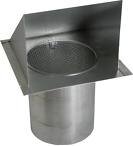I installed an OAK for my RSF 11 years ago and being a fireplace, it is not accessible to retrofit a damper in-line. If/when I burn 24/7 I don't have any problem not being able to shut it off completely but in very cold weather, if there is no fire, I get frost forming on the metal manifold above the door and on the glass from the air wash system. RSF has a notch in the butterfly so it's not possible to shut down the air completely. My chimney is chased up through the interior so it drafts constantly.
The OAK is installed low, just above the sill plate. I have crawlspace access under the fireplace. I'm thinking of drilling a small hole at a downward angle through the sill plate, subfloor, and top plate of the foundation wall into the crawlspace using a long cable installer's drill bit. Then I will drill another hole beside the hearth down through the floor into the crawlspace and fish a choke cable through the holes to the outside. My OAK has a wedge shaped hood as shown below. I will cut a rectangle of metal to use as a damper, hinge it at the top, and connect the choke cable to the bottom. Maybe some closed cell peel-n-stick foam for a good seal, maybe not. I wonder if I should let a bit of air leak in just in case I forget to open it and light a fire.
The OAK is installed low, just above the sill plate. I have crawlspace access under the fireplace. I'm thinking of drilling a small hole at a downward angle through the sill plate, subfloor, and top plate of the foundation wall into the crawlspace using a long cable installer's drill bit. Then I will drill another hole beside the hearth down through the floor into the crawlspace and fish a choke cable through the holes to the outside. My OAK has a wedge shaped hood as shown below. I will cut a rectangle of metal to use as a damper, hinge it at the top, and connect the choke cable to the bottom. Maybe some closed cell peel-n-stick foam for a good seal, maybe not. I wonder if I should let a bit of air leak in just in case I forget to open it and light a fire.


